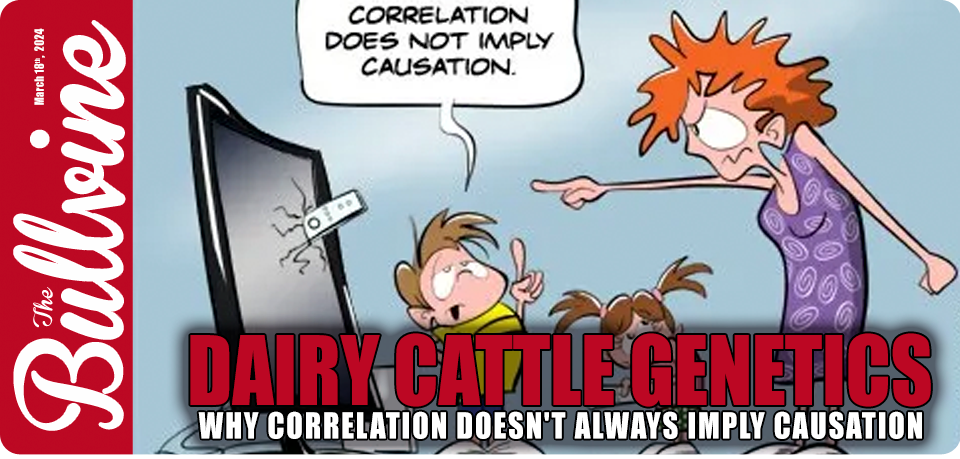Genetics is important in dairy production since it determines cow productivity and health. Farmers often use breeding programs to select features like milk production, fertility, and disease resistance. However, while evaluating the link between genetics and desired outcomes, it is critical to realize that correlation does not necessarily indicate cause. Correlation establishes a statistical relationship between two variables, while causation suggests that one variable directly influences the other[1]. This difference is critical in genetic research because it prevents data misinterpretation and ensures that breeding and management techniques are founded on an accurate knowledge of genetic factors.
Structural Equation Modeling (SEM) in Dairy Cattle Genetics
Structural equation modelling (SEM) is a statistical approach for representing causal links between phenotypic features and estimating their size. SEM investigates the functional relationships between variables in a phenotypic network, enabling researchers to use one characteristic as a predictor of another. This strategy has been used to separate the effects of single-nucleotide polymorphisms (SNPs) on characteristics into direct and indirect components, as well as to find genomic areas with pleiotropic effects that explain observed genetic correlations. For example, SEM has been used to study the genetic architecture of udder health in dairy cattle, a feature with important economic and animal welfare consequences owing to illnesses such as mastitis.[2]
Genetic Correlations and Causal Effects
However, demonstrating a link between genetics and a characteristic does not always imply that one causes the other. Other factors might be at play, influencing both variables separately. Environmental variables affecting dairy cow production and health include feed, housing conditions, and management approaches.
Furthermore, correlations might be spurious, which means they occur by chance rather than reflecting a real link. Without strong experimental data, it is difficult to tell if a correlation indicates a causal link.
Consider a hypothetical situation in which researchers discover a substantial relationship between a certain gene variation and milk output in dairy animals. While this association may imply a genetic effect on milk production, further research is required to determine causality.
Research has shown intricate genetic and phenotypic links between many fitness components in cattle. For example, genetic connections and causal impacts of fighting abilities have been shown to influence fitness parameters such as milk production, somatic cells, and fertility. However, correlations may not necessarily indicate causality. For example, SEM demonstrated a negative link between fighting skill and lifespan, but MTM revealed a favorable correlation. This disparity shows that dominant cows are retained longer for economic reasons, rather than because fighting ability leads to longer life.
Experimental investigations, such as genetic modification or controlled breeding experiments, may give stronger proof of causation. Researchers can determine if certain genes directly impact desired outcomes in dairy cattle by systematically manipulating genetic components and analyzing the subsequent changes in attributes.
Longitudinal studies that follow cattle performance throughout numerous generations may also assist in understanding the intricate interaction between genetics and environmental influences. These investigations enable researchers to analyze how genetic features are transmitted and expressed under various situations, shedding light on their practical relevance for dairy producers.
Methane Emission and Genetic Correlations
A meta-analysis of the genetic contribution to methane emission in dairy cows found heritability estimates for multiple methane emission variables and negative genetic associations with adjusted milk output for fat, protein, and energy. This suggests that, although there is a genetic foundation for methane emission, it does not always result in changes in milk output or composition. [3]
Social Dominance and Fitness Traits
Social dominance in cattle has been linked to genetic features including muscle mass, fertility, and udder health. However, these relationships, whether direct or indirect, do not demonstrate causality but rather point to probable evolutionary trade-offs.
Implications for Dairy Cattle Breeding
The difference between correlation and causality has a substantial impact on breeding methods. Efficient sire selection, for example, has an influence on genetics in a dairy business; nevertheless, to minimize unexpected repercussions, features should be selected based on causal linkages rather than correlations.
Genetics of Survival in Dairy Cows
Understanding the genetics of survival is particularly important, since early death and culling result in large losses. Genetic relationships between survival and other variables such as longevity and fertility are positive, but low heritability estimates for survival suggest that environmental factors may play a greater role.
The Bullvine Bottom Line
In dairy cow genetics, SEM and other statistical approaches have shown genetic relationships between several phenotypes. However, correlation does not necessarily indicate causality. This information is critical for making educated choices about breeding and management approaches that improve dairy herd health and production. Although correlations between dairy cow genetics and variables such as milk production might help discover possible relationships, they should be taken with care. Correlations cannot clearly demonstrate causality in the absence of robust experimental validation. Dairy producers and academics must acknowledge the limits of correlation and emphasize rigorous scientific methodologies to find the actual causes of cow production and health.
[1] Genetic correlations and causal effects of fighting ability on fitness traits in cattle reveal antagonistic trade-offs https://www.frontiersin.org/articles/10.3389/fevo.2022.972093/full
[2] Structural equation modeling for investigating multi-trait genetic architecture of udder health in dairy cattle https://www.nature.com/articles/s41598-020-64575-3
[3] Structural equation modeling for investigating multi-trait genetic architecture of udder health in dairy cattle https://www.nature.com/articles/s41598-020-64575-3

















